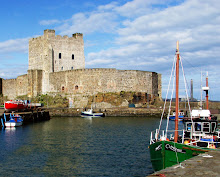 This gate at the Harland & Wolf shipyard in Belfast continues to pique my interest. To me, the iron retains its strength and beauty but as I look at the photograph I could kick myself for not taking more time to study the construction. Some parts of the gate look like wrought iron while others are clearly cast. Where they made in the shipyard or is there a name of an artist or foundry inscribed somewhere among those weeds? When were they fabricated? I assume it was sometime after WW II because most ornamental iron railings and gates were collected at the start of the war and turned into steel for munitions. I hope they are still there next time I visit Belfast and I can get some answers.
This gate at the Harland & Wolf shipyard in Belfast continues to pique my interest. To me, the iron retains its strength and beauty but as I look at the photograph I could kick myself for not taking more time to study the construction. Some parts of the gate look like wrought iron while others are clearly cast. Where they made in the shipyard or is there a name of an artist or foundry inscribed somewhere among those weeds? When were they fabricated? I assume it was sometime after WW II because most ornamental iron railings and gates were collected at the start of the war and turned into steel for munitions. I hope they are still there next time I visit Belfast and I can get some answers.Doors hold a fascination for me. There are intrinsic differences in function, form, and construction. Equally, doors are wonderful metaphors. What allusions can be drawn from a neglected shipyard gate surrounded by rampant weeds?
The last couple of doors are from churches. The first is at the church located in Jerusalem where the Pool of Siloam is thought to have been. Those closed doors reminded me of the quatrain by Omar Khayyam:
There was a Door to which I found no Key:
There was a Veil through which I could not see:
Some little Talk awhile of Me and Thee
There seemed -- and then no more of Thee and Me.





